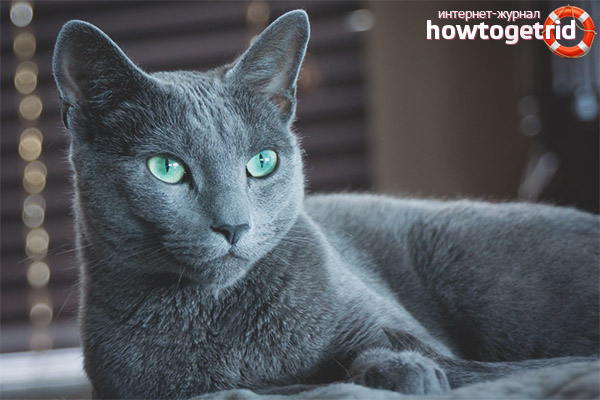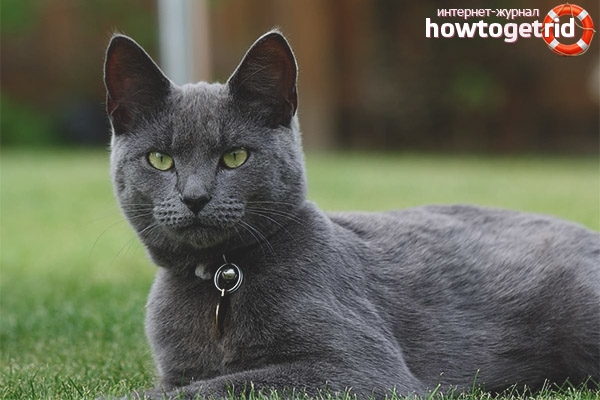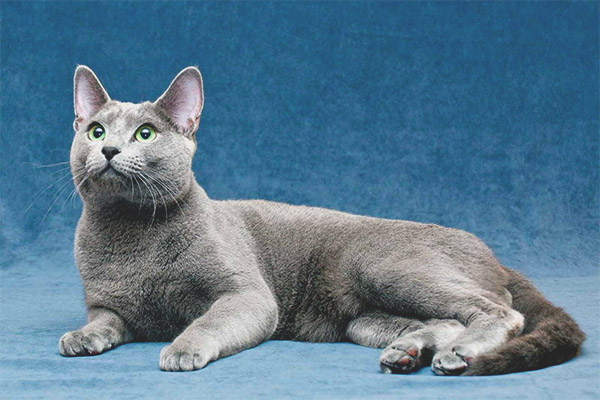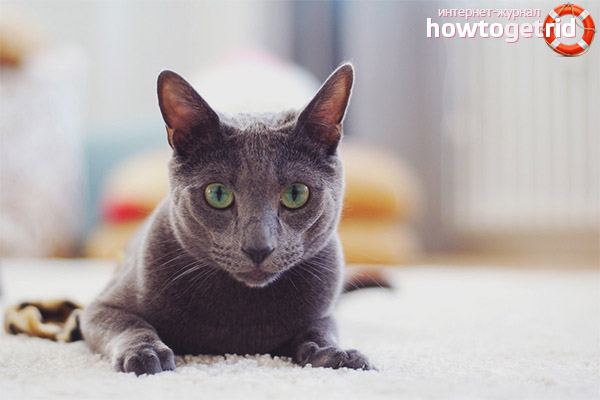The content of the article
- 1 The history of the breed
- 2 Breed standards and its features
- 3 Characteristics of wool cover
- 4 Colors
- 5 Character traits
- 6 Russian blue cats and children
- 7 Features of maintenance and care
- 8 Health features
- 9 How many Russian blue cats live?
- 10 How much is a Russian blue cat?
- 11 Where can I buy a Russian blue cat?
- 12 Video: Russian blue cat
The appearance of the breed of Russian blue cats is impossible to know for sure. It is known for certain that this breed is of aboriginal origin. Their history is quite old, because the breed appeared as early as the 16th century, and even then it spread to France, Spain, Scandinavia, Great Britain. But judging by the name, Russia is considered to be the home of the Russian blue. The formation of breed standards was very long before the cats of this breed acquired the present traits of appearance and character.
The history of the breed
The appearance of the Russian blue cat has undergone some changes over time.Breeders crossed them with representatives of other breeds - the Siamese, the British, to obtain the ideal pedigree data. This was done to ensure that the breed received a stronger health and the most attractive appearance. With the help of the British blue cats got a more beautiful coat. But crossing with the Siamese played a cruel joke with the breeders, increasing the negative qualities in both breeds. Therefore, the breeders agreed - to stop the breeding experiments and make maximum efforts to return the Russian blue cats to their original form.
This cat gained the greatest popularity in the twentieth century. Russian and rulers, Nicholas 2 and Queen Victoria appreciated this breed of cats. It was their representatives that they preferred to keep as pets.
Breed standards and its features
Breed standards of Russian blue established over the centuries. Breeders are well aware that through generations of breeding, the appearance of representatives of the breed accepts some changes and becomes more attractive to humans.Animal health is also getting stronger.
Today, the Russian blue cat must meet the following breed standards:
- Torso Cats of this breed are of medium size. The body looks somewhat elongated and graceful. Cats of this breed should be graceful and aristocratic. Individuals with extra pounds are often disqualified at exhibitions and removed from breeding.
- Head. Triangular regular shape. Elongated and elongated.
- Muzzle. The profile should be straight and the forehead flat. When viewed from the front, the cat’s nose and chin should be on the same vertical line, without deviating to one side or the other. Malocclusion is an indicator of the animal to be excluded from breeding.
- Ears. Should be widely spaced, large in size and of sufficient length, with a broad base and sharp tips. The ear shells should be pink.
- Paws. Should be long, slim and muscular. Part of the paws with pads of medium size and looks subtle in relation to the body of a cat.
- Neck. Should not be too narrow or wide. Be sure to even.
- Eyes. Must necessarily have a green color, be widely planted and large, almond-shaped.
- Tail. Enough long length with a tight coat.Must have a sharp tip.
- Dimensions and weight. Russian blue cats are of medium size, the weight of the female is about 3.5 kg on average, the cat is about 5.
The breed standards and its description may have some differences for different systems for evaluating the breed characteristics, while observing the main features of the Russian blue cat. Today, breeders have priority in preserving the breed in its original form.
Characteristics of wool cover

Cats of this breed have wool, well-groomed in appearance from nature. It should be smooth, silky and healthy. Hair dense texture. Wool should be the same length throughout the body of the animal with the presence of a thick undercoat. It is needed to maintain the desired body temperature of the cat and protect it from moisture. Hair undercoat should match the color with a shade of the entire hair of the animal.
Colors
Russian blue cat most often corresponds to its name, so the main tone of the fur of these animals is blue. It can be very bright and almost dark. It does not really matter, as long as it is blue.Many breeders are engaged in breeding ideal in their opinion shade of wool in cats of this breed.
Character traits
Russian blue cat is a typical aristocrat not only in appearance, but also in the inner world. They have a phlegmatic temperament. Completely balanced, obedient and extremely calm. They are distinguished by a strong attachment to their own masters, for whom they are ready for anything. Russian blue are distinguished by outstanding intellect as well as intelligent manners. Sufficiently amenable to learning and quickly get used to changes in conditions of detention. Their most famous feature is undeniable love and devotion to the owner.
A huge plus is that the Russian blue cat tolerates loneliness perfectly. They, of course, miss their master, but do not experience stress in the absence of it.
Cats of this breed are extremely inquisitive and curious. They are interested in the outside world and all that is in it, whether it be new territories, animals, plants or objects. The owner will never take the trouble to take something a pet, if he is a representative of Russian blue cats.
Even the representatives of this aristocratic and sophisticated breed are wonderful hunters. This is noted by all owners of representatives of this breed. No mouse or bird can hide from Russian blue. Owners should take this into account when keeping cats of this breed in the house along with other animals.
Russian blue cats and children
The positive distinctive feature of this feline breed is that they are just great for children. The Russian Blue cat is very patient and condescending. Therefore, she is not only a loyal friend of her master, but also a very good nurse for small children.
Often, domestic cats perceive human children as well as the kittens of their relatives. The animal is clearly aware that in front of him is a child. But, of course, there are exceptions. It all depends on the individual characteristics of the nature of the pet. Nevertheless, cats of the Russian Blue breed are notable for their special patience, calmness and balance. There is no better friend for cats for a baby than a Russian blue cat.
Features of maintenance and care
Russian blue cat unpretentious in maintenance and care. She has a short coat that does not require complex care. It is enough to bathe it every six months (no more) or as extreme as necessary. Cats of this breed are clean enough and can independently keep themselves in proper form.
It is necessary to comb a cat in order to remove loose hairs by yourself. This will not only help the animal, but also contribute to the maintenance of cleanliness in the house. This should be done with a soft or silicone brush, as well as a comb with fine teeth.
To protect your pet from possible infection with parasites and fleas, you can purchase a special collar. For prophylactic purposes, de-worming should be carried out about once every 6 months, with the help of preparations of complex action (namely, on round and tapeworms). This should be done with the help of special preparations purchased at the veterinary pharmacy, in compliance with the dosage, based on the weight of the pet. Some mistakenly believe that a cat that lives in a house or apartment without going outside cannot become infected with worms. However, this opinion is very wrong.Parasites can enter the body of an animal from poorly heat-treated meat, fish, from other animals, and even from the owner.
The teeth of the cat must also be cleaned. This should be done once or twice a week with a special paste and brush. Teaching a kitten to brushing your teeth is necessary from a very early age, but you can teach a cat to grow up. For this you need to take the paste and brush. Moisten the brush with water and apply a very small amount of special cat paste on it. Kota fix with one hand, gently holding his mouth open with your fingers. Use your other hand to brush the hygiene. With a slight pressing movement, you need to clean the canines first and then all the other teeth. Special attention should be paid to teeth located in the corners of the mouth. If an animal is very indignant when brushing its teeth, then you should not blame it for its nasty temper, perhaps it has just sensitive teeth.
Health features
Thanks to competent centuries-old selection and good conditions of detention, the Russian blue cat is distinguished by good health and goodlongevity. Representatives of this breed very rarely have genetic pathologies and diseases.
Unfortunately, the Russian blue cat loves to eat very much. Therefore, it is necessary to control the quality and quantity of food consumed by it, in order to avoid problems with overweight. Excess weight has not made anyone more attractive and healthy, Russian blue cats, including.
Certain abnormalities may occur on the part of the bones and teeth of the cat. To avoid this, the diet of the animal must be balanced and complete. If it is not possible to prepare your pet high-quality food yourself, then you need to choose high-quality food with vitamin-mineral complexes.
When feeding cats with natural food, food may not always be balanced and useful. In this case, it is better to add complex vitamins to the diet in order to maintain the health of the pet in good condition.
How many Russian blue cats live?

Russian blue cat - cat long-liver. Representatives of this breed live long enough and can live even up to twenty years on condition of good nutrition and living conditions.Since they have good health, they remain active until the last days of life. On average, the life span of a Russian blue cat is about 17 years.
How much is a Russian blue cat?
Be sure to carefully consider the choice of the sex of the cat. Cats usually cost less than females. It should be borne in mind that when buying an animal of a certain sex for breeding, it will be necessary to provide conditions for the cat for breeding, for the cat for raising kittens.
Where can I buy a Russian blue cat?
Of course, it is better to buy a purebred kitten in a specialized nursery or at exhibitions. Due to the prevalence of the breed in the post-Soviet countries, it is unlikely that there will be any difficulty in finding kittens. Breeders of Russian blue cats are in almost all major cities of Russia and Ukraine.
However, if the future owner did not find a baby of this breed in the city of residence, you should not buy an animal remotely. It is better to visit the nursery on your own to see the conditions in which the cats are kept, to see all the documents and carefully examine the future pet before you buy. Perhaps this will require a little time and additional costs. Nevertheless, a personal meeting with the sellers during the transaction will make it possible to know whether it is worth buying a kitten from him.
Video: Russian blue cat












To send